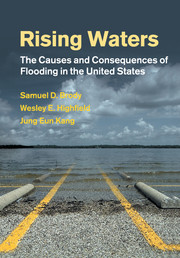Book contents
- Frontmatter
- Contents
- Preface
- Acknowledgments
- Abbreviations
- 1 Introduction: rising waters
- Part I The consequences of floods
- Part II Planning decisions and flood attenuation
- Part III What are we learning?
- Part IV Policy implications and recommendations
- 11 Flood policy recommendations
- 12 Conclusions
- References
- Index
11 - Flood policy recommendations
from Part IV - Policy implications and recommendations
Published online by Cambridge University Press: 28 April 2011
- Frontmatter
- Contents
- Preface
- Acknowledgments
- Abbreviations
- 1 Introduction: rising waters
- Part I The consequences of floods
- Part II Planning decisions and flood attenuation
- Part III What are we learning?
- Part IV Policy implications and recommendations
- 11 Flood policy recommendations
- 12 Conclusions
- References
- Index
Summary
The purpose of our study is to better understand the causes and consequences of flooding so that our findings can help inform local jurisdictions on how best to mitigate hazards at the local level. Based on the results of our empirical analyses, we present a series of policy recommendations as guidance to effectively mitigate the adverse impacts of floods. Decision makers, coastal stakeholders, and other interested parties within and outside of our study areas can use the following recommendations to enhance the flood resiliency of their communities.
Nonstructural flood mitigation strategies are a viable alternative
Through both quantitative and qualitative evidence, we have shown the effectiveness of using nonstructural mitigation techniques to reduce the adverse impacts of flooding events. The rush to build levees, dams, and other public works after a destructive flood should be met with caution. As already noted, these structures are not infallible, require considerable financial resources, and can induce a false sense of security leading to increased development in vulnerable areas. In contrast, nonstructural, land use-based measures may significantly reduce observed property damages from floods by guiding development away from flood-prone areas. Time and time again, using multiple statistical procedures, we have shown the value of this approach for enhancing the resiliency of coastal communities. Based on our data, the most effective strategies include setbacks or buffers, “pocket” protected areas, strong construction and building codes, and specific flood policies embedded into local land use plans.
- Type
- Chapter
- Information
- Rising WatersThe Causes and Consequences of Flooding in the United States, pp. 173 - 180Publisher: Cambridge University PressPrint publication year: 2011



